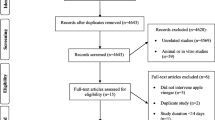Abstract
Background:
In a population-based multicenter case-control study of diet, life-style, and gastric cancer a large series of adults, aged 30–75 years (mean 58.9 yearss), were randomly sampled from the general population in 3 areas of Central-Northern Italy.
Aim of the study: To evaluate the relationship between plasma levels of antioxidant vitamins and cholesterol, and sociodemographic characteristics, life-style factors, and dietary intake of selected nutrients in a sample of the Italian population.
Methods: A fasting blood sample was available for 945 subjects (553 men, 392 women). The plasma concentrations of ascorbic acid, carotene, retinol, alpha-tocopherol, and cholesterol were determined by a centralized laboratory. All participants answered to a detailed questionnaire collecting information on sociodemographic and anthropometric characteristics, smoking, alcohol drinking, and dietary habits. Covariance analysis models, with post hoc Dunnett tests, including terms for age, sex, study center, and period of blood drawing, were used for selected multiple-way comparisons of mean values of plasma nutrients.
Results: Mean plasma values of retinol were higher among men while women had higher levels of plasma carotene, ascorbic acid, alpha-tocopherol, and cholesterol. Plasma carotene levels showed an inverse association with body mass index, alcohol consumption, and smoking and a positive association with social class. Carotene concentrations were higher in plasma samples obtained in spring/summer, while ascorbic acid levels were higher in autumn/winter. Partial correlation coefficients between carotene and ascorbic acid (0.69 in men; 0.74 in women), between carotene and alpha-tocopherol (0.44; 0.37), and between alpha-tocopherol and ascorbic acid (0.45; 0.41). Plasma alpha-tocopherol and retinol correlated with plasma cholesterol. On the other hand, plasma carotene and ascorbic acid were correlated with their estimated dietary intakes, while the intakes of other nutrients, as expected, correlated rather poorly with the respective plasma concentrations.
Conclusions: Socio-economic factors, life-style, and specific nutrient intake, in addition to gender, are related to nutrient plasma levels in Italian adults and may provide specific suggestions for the prevention of chronic diseases.
Similar content being viewed by others
Author information
Authors and Affiliations
Additional information
Received: 8 December 1998, Accepted: 25 February 1999
Rights and permissions
About this article
Cite this article
Palli, D., Decarli, A., Russo, A. et al. Plasma levels of antioxidant vitamins and cholesterol in a large population sample in Central-Northern Italy. Eur J Nutr 38, 90–98 (1999). https://doi.org/10.1007/s003940050049
Issue Date:
DOI: https://doi.org/10.1007/s003940050049




